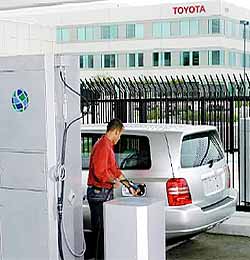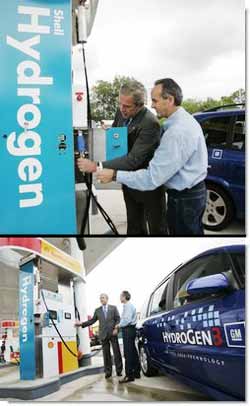Hydrogen Fueling Stations
Hydrogen Fueling Stations
Hydrogen fueling stations are an essential component to the success of future hydrogen cars running upon the nation’s hydrogen highways. With hydrogen fuel stations in place, one of the largest infrastructure challenges will be solved. But, this will not happen overnight. The hydrogen fueling stations of the future may be both standalone ports or a complementary part of current gasoline stations.
|
|
President George W. Bush talked about the future of hydrogen power in his 2003 State of the Union Address. On May 25, 2005, President Bush took a tour of a hydrogen fuel station inside a Shell gasoline station in Washington D. C. Because the gasoline station infrastructure is already built, it would make a lot of sense for these stations to simply add a hydrogen fueling terminal or two as the hydrogen highway starts to heat up for consumers. |
Currently, California has 23 active hydrogen fuel stations across the state, which are fueling 158 fleet vehicles. Fourteen more fuel stations are under construction. California’s first hydrogen fuel station open to the public was christened on April 13, 2004 in Diamond Bar in the southern part of the state.
The South Coast Air Quality Management District (AQMD) hosts the Stuart Energy SES-f hydrogen fueling station, which has attracted international attention from the Netherlands, Czech Republic, Belize, Switzerland, Philippines, New Zealand, Canada, Japan, China, South Africa, Latvia, and the Republic of Georgia.
|
The Stuart Energy Station was also chosen by Toyota to provide hydrogen fueling infrastructure to its headquarters in Torrance, California.
|
 Stuart Energy |
Other hydrogen fueling stations across the world include those in Germany, Lisbon, Sweden, United Kingdom, The Netherlands, Luxemburg, Portugal, Spain, Iceland, Australia, Hong Kong, Japan, Canada, Italy, Belgium, South Korea, Singapore and Taiwan. For more information on worldwide hydrogen fueling stations see the hydrogen fueling stations locator maps page.
There are many issues that need to be worked out with hydrogen fueling stations as they relate to hydrogen car technology. For instance, currently, there are two kinds of hydrogen cars. One car uses hydrogen fuel cells and the other car uses an internal combustion engine (ICE) to burn hydrogen. A hybrid car also exists that switches back and forth between gasoline and hydrogen ICE’s. Some hydrogen cars currently use compressed H2 while others use liquid hydrogen. Issues of storage, containment, delivery and safety all need to be addressed before hydrogen fuel stations become commonplace in the consumer market.
Besides commercial fueling stations, the future may hold that home hydrogen fueling stations become commonplace. By the process of electrolysis, an electrical current can split tap water into hydrogen and oxygen, thus making it possible to fuel up your car at home before you hit the road. For more information on electrolysis see the Hydrogen Electrolysis page.
Here are some more photos that I’ve taken of the hydrogen filling station in Irvine, California.
More Information From Our Blog
Relevant External Link
Best Practice Guide for installing hydrogen refuelling stations courtesy Scottish Hydrogen & Fuel Cell Association -Here
Written by Hydro Kevin Kantola
Leave a Reply
You must be logged in to post a comment.
